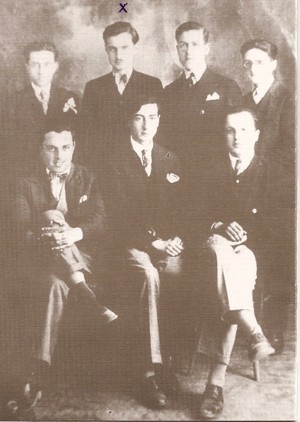© Turkuvaz Haberleşme ve Yayıncılık 2024
The first literary movement of the Republican era was the "Yedi Meşale" (Seven Torches) featuring seven young poets and story writers, namely Yaşar Nabi Nayır, who would be the founder of the "Varlık" publishing house supporting secularist literature, Sabri Esat Siyavuşgil, the translator of Cyrano de Bergerac, Muammer Lütfi Bahşi, Kenan Hulusi Koray, Vasfi Mahir Kocatürk, a historian of literature, Cevdet Kudret Solok and Ziya Osman Saba. The movement emerged through a book titled, "Yedi Meşale" (Seven Torches) depicting seven literary texts from the seven young authors. Though they were very popular at that time, the six authors of the movement other than the poet Ziya Osman Saba do not have an audience today.

Ziya Osman Saba (back, 2-L) with the Seven Torches group.
"Seven torches" also began publishing a literary magazine named "Meşale" (Torch); however, they failed, managing to publish only eight issues of the "Meşale." Indeed, "Meşale" was published in Ottoman script, and the state banned it in order to adopt the Latin script. So, the young publishers decided to close it down. After the "Revolution of Letters" (ban of the Ottoman script and adoption of Latin script), the "Seven Torches" movement was dissolved. Though many of them stayed in close relationships, they would never gather again as a group.
After the "Garip" (Strange) and Second New movements, the "Seven Torches" were left because of the new common literary taste. Only Ziya Osman Saba was read by the followers of these modernist movements. Saba is still considered as one of the most prolific lyrical poets of the Republican era.
Early life
Ziya Osman Saba was born on Mar. 30, 1910 in Beşiktaş, Istanbul. His father Major Osman Bey was the military attache of Turkish Republic at Paris. Ziya lost his mother at age eight. He would carry the sorrow of his mother's death to his poems.
Ziya attended at Galatasaray High School as a boarder after his mother's death. He went to school and lived at Galatasaray until his graduation in 1931. He began writing poetry at Galatasaray. His best friend at the Galatasaray High School was Cahit Sıtkı Tarancı, a prolific lyrical poet. Ziya Osman and Cahit Sıtkı have always been remembered together. Their communication is also famous and their mutual letters have been published several times.
The fountain and the pigeons
Feelings such as melancholy, pain, sorrow, sadness, homesickness, longing and nostalgia are at the center of Ziya Osman's poems. He first published a poem of his in the "Serveti Fünun-Uyanış" literary magazine in 1927 as he was in high school. In 1928, he joined the "Seven Torches" movement and became famous before his graduation from the high school. He was among the young publishers of the "Meşale" literary magazine supported by Yusuf Ziya Ortaç, a famous poet of that time. After the "Revolution of Letters" and closing the "Meşale," Ziya Osman began publishing his poems in such newspapers as "Milliyet" (The Nation) and "İçtihat" (Opinion) before his friend Yaşar Nabi published the "Varlık" (Existence) literary magazine in 1933. After that, he became one of the regular poets of "Varlık."
After graduating from high school, Ziya Osman married with his cousin Nermin, who was mentally ill. They stayed married for 10 years. Within these years, Nermin would occasionally be hospitalized due to her mental breakdowns. This problematic marriage devastated the poet, and he reflected his devastation, frustration and grief in his poems.
Ziya Osman attended the School of Law in the Istanbul University in 1931. He would graduate from there in 1936. Meanwhile, he began working as an accountant at the "Cumhuriyet" (Republic) daily newspaper. After his graduation from the School of Law, he began working as a legal consultant at the "Emlak Kredi Bankası" (Estate Credit Bank) until 1945. He finally worked as the chief-proofreader for the National Education Ministry's publication house.
In 1945, Ziya Osman married Rezzan Hanım, a colleague at the Emlak Kredi Bank. They had two sons, Osman and Orhan, they named after the first two sultans of the Ottoman State.
In 1950, he retired because of his heart illness and dealt with small works at his friend Yaşar Nabi's "Varlık" publishing house until his death in 1957.
Pain and piety
Love, pain and nostalgia were the focal points of Ziya Osman's poems, short stories and personal letters as well. He always lived in a state of pathos. His small lyrical poetry is still read and loved thanks to this empathetic concentration.
Besides, some readers love Ziya Osman's piety, which I think was not a natural consequence of his thoughts about religion. His piety in poetry comes from a search for compensation. He lost his mother when he was only 7 years old. He was a boarding student through his childhood and youth. He was not close to his father either. Finally, he married an ill woman. He lost all the people he loved; or, perhaps, he loved to lose.
The religious imagery of Ziya Osman poetry does not come from the Islamic tradition. He finds himself as an innocent lamb before the harshness of life. He sometimes reflects his image as a crucified believer, which is not the image of the believers in Islam. His famous poem on the life after death reads as follows:
"I am a stranger in this strangest world
Lord, seeing my griefs, years after
Shall order one of his angels, "It's time!"
And shall be closed the eyes of mine."
Ziya Osman's persona never lives real life in real time. He is always nostalgic, refusing the "strange" reality. His subjectivity preserved time's decay and created a timeless lyricism.
